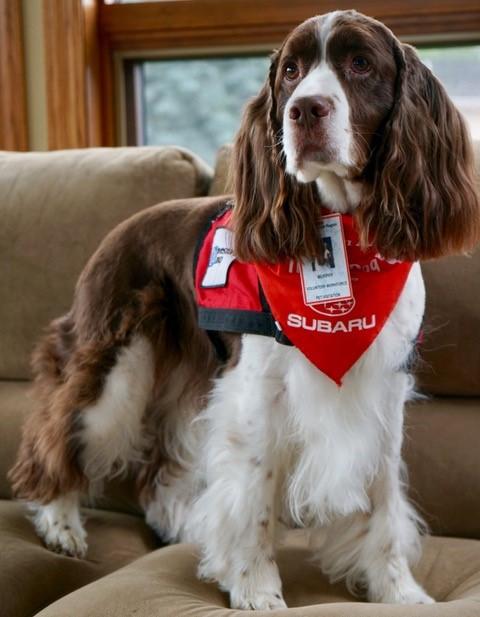A visit from a dog can reduce the distress of patients waiting for emergency treatment in hospital,

Credit: Jane Smith
A visit from a dog can reduce the distress of patients waiting for emergency treatment in hospital, a study by the University of Saskatchewan (USask) shows.
Patients who spent 10 minutes with a visiting therapy dog–a four-year-old springer spaniel named Murphy–reported they felt more comfortable, happier and less distressed while waiting for emergency care in hospital.
The study, published in the Patient Experience Journal, found a significant increase in comfort levels and positive feelings after spending time petting, cuddling or interacting with the experienced canine.
The study was carried out at the Royal University Hospital (RUH) in Saskatoon, Saskatchewan–the first emergency department in Canada to introduce therapy dogs to improve the experience of waiting patients.
There is growing evidence that therapy or comfort dogs can be beneficial to human health and can reduce anxiety, heart rate and blood pressure. Interaction with a dog increases production of dopamine, a neurotransmitter, which reduces the stress hormone cortisol.
Professor Colleen Dell, Research Chair in One Health & Wellness at USask’s College of Arts and Science, co-led the study with emergency physician Dr. James Stempien, MD, Provincial Department Head, Emergency Medicine in Saskatchewan. The research was supported by the Saskatchewan Centre for Patient-Oriented Research.
“Emergency departments are hectic and confusing places. Most people waiting for treatment feel nervous, and waiting can increase their pain. It is well-known that interacting with animals can help humans feel calm and relaxed. Our study showed a noticeable improvement in the patient’s mood after interacting with a therapy dog,” Dell said.
“With waiting times consistently high in emergency departments, it suggests that therapy dogs may have a broader therapeutic role to play comforting patients in distress and pain.”
RUH is the first emergency department in Canada to allow therapy dogs to visit, with up to six trained therapy dogs now visiting several days a week.
Patients met the dog for between 10 and 30 minutes and included people with cardiac complaints, fractures, psychiatric issues, and those suffering chronic pain.
The 124 patients were waiting in curtained-off cubicles and found their distress levels decreased, and their perceived comfort levels increased after interacting with the spaniel, a certified St. John Ambulance Therapy Dog and its handler. The distress of patients meeting Murphy decreased regardless of the length of their wait.
Patients filled out questionnaires about their well-being and feelings before and after meeting Murphy. The most common themes were feeling ‘happy’, ‘okay’, ‘better’ and ‘calm’, and 80 per cent expressed happiness during the visit and said they felt calmer after the visit.
Sixty six per cent of those visited by Murphy patted him, stroked him or cuddled him. One patient gave the dog a massage and some snuggled up to him or let the dog put his head on their chest. In almost a quarter of cases, the dog’s ‘intuition’ when interacting with a patient was noted.
Logan Fele-Slaferek, a co-author of the paper and patient advocate, met Murphy on several occasions while an RUH inpatient for a recurrent health condition. On one occasion, after a six-month-long treatment program had failed and he was feeling ‘crushed and hopeless’, the spaniel jumped on Logan’s lap and fell asleep.
“I was a little skeptical about his helping at first, but that all changed five minutes later. The dog picks up on your mood or temperament better than most people would. He helped my recovery immensely. It’s something about being next to an animal that exudes nothing but love and kindness,” Fele-Slaferek, an undergraduate at USask, said. “The emergency department can be so hectic, but time slows down when you are with a therapy dog. His presence is soothing.”
Jane Smith, Murphy’s handler, said it is clear the therapy dog enjoys meeting the patients, and sometimes does not want to leave them.
“When Murphy enters the emergency department, the mood changes quickly. You can see patients, doctors, and staff smiling, even before he actually visits anyone,” she said. “During the visits he looks at patients with big, brown eyes, settling in to enjoy the pets and cuddles. Sometimes, Murphy needs extra encouragement to leave a patient. It is actually hard to tell who enjoys the visit more.”
This preliminary study has led to Dell and her team being awarded a research grant of $20,000 from the Royal University Hospital Foundation to undertake further research at RUH into the impact of therapy dog visits on adult emergency department patients and their experiences of pain.
###
Media Contact
Jennifer Thoma
[email protected]




